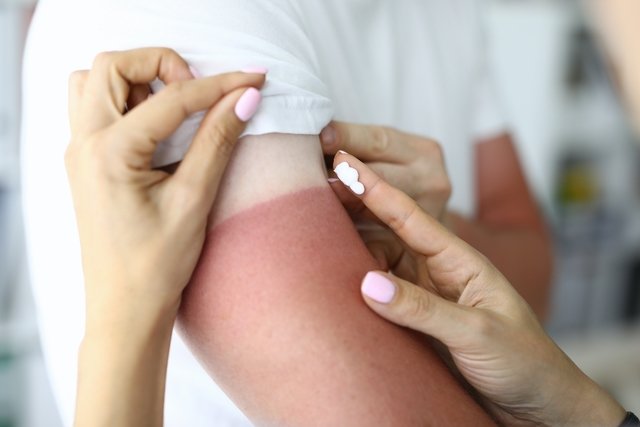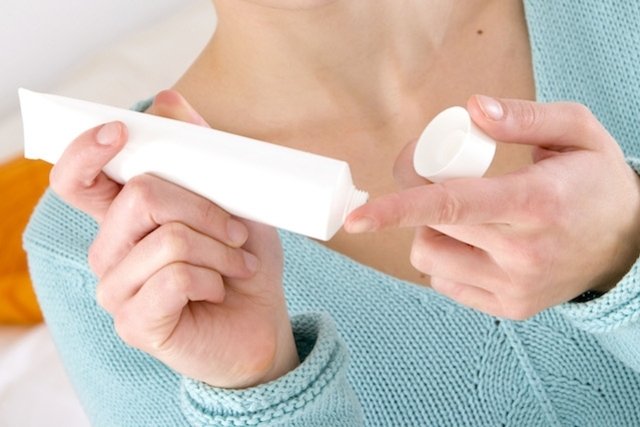Burn ointments, such as dexpanthenol or desoximethasone, can be used to treat 1st degree burns, with symptoms such as redness, swelling, pain or discomfort in the skin, as they help to relieve pain and inflammation, promote skin healing or prevent the emergence of infections.
1st degree burns can occur due to contact with extreme heat, such as touching a hot pan or after exposure to the sun without using sunscreen, in addition to contact with extreme cold or chemical substances, for example.
These ointments can be purchased at pharmacies or drugstores and, generally, do not require a medical prescription, except for ointments containing antibiotics, which are only sold with a prescription, and are indicated for mild 1st degree burns without blisters or peeling on the skin. Know how to recognize a 1st degree burn.

Main ointments
The main ointments that may be recommended by a doctor to treat burns are:
1. Dexpantenol
Dexpanthenol ointment is recommended for 1st degree burns that have not formed a blister, as it helps to regenerate skin cells and has a moisturizing, protective and nourishing action, due to the vitamin B5 in its composition, helping with skin healing.
This ointment can be found under the trade names Bepantol or Bepantol derma or with the similar name Probentol derma, and can be applied to the burn 1 to 3 times a day.
2. Neomycin sulfate + zinc bacitracin
Neomycin sulfate + zinc bacitracin burn ointment is a combination of two antibiotics that act by inhibiting the growth of bacteria, preventing infections caused by burns, in addition to helping the skin heal.
This ointment should only be used on the skin and can be found under the trade names Nebacetin or Cicatrisan, or under the generic name neomycin sulfate + zinc bacitracin.
Neomycin sulfate and zinc bacitracin ointment is sold with a medical prescription and is indicated when signs of infection such as pus or excessive swelling of the skin with burns appear, and should be applied 2 to 5 times a day with the help of gauze, as per medical advice.
3. Desoxymetasone
Desoximethasone burn ointment is a corticosteroid with anti-inflammatory action, which helps to relieve redness and swelling of the skin, and improve skin healing, and is recommended for 1st degree burns caused by exposure to the sun.
This ointment is sold under the trade name Esperson and can be used on the skin 1 to 2 times a day, under the advice of a healthcare professional, and should not be applied to large areas of the skin as it can cause side effects such as blurred vision. , eye pain, increased thirst or the urge to urinate, dry mouth, weight gain, facial swelling, muscle weakness, depression, anxiety or irritability.
4. Silver sulfadiazine
Silver sulfadiazine is an ointment indicated for the treatment and prevention of infection in skin burns, as it has antibacterial action, preventing the multiplication of bacteria, in addition to having anti-inflammatory properties, promoting skin healing.
This burn ointment can be found under the trade names Dermazine or Dermacerium, or under the generic name silver sulfadiazine, and is sold with a prescription.
Silver sulfadiazine can be used on the skin 1 to 2 times a day, for severe burns or 2nd or 3rd degree burns, after evaluation by a doctor or nurse. Know what to do in case of a serious burn.
Read too: 14 treatments for 3rd degree burn
5. Clostebol acetate + neomycin sulfate
Clostebol + neomycin burn ointment has anti-inflammatory and antibacterial action, which works by stimulating the formation of new skin cells, facilitating healing, and preventing bacterial infections, being indicated for the treatment of mild burns.
This ointment is sold with a prescription and can be found under the trade name Trofodermin dermatological cream or under the trade name clostebol acetate + neomycin sulfate and should be used on the skin 1 to 2 times a day as per medical advice.
6. Sulfacetamide sodium + trolamine
Sodium sulfacetamide and trolamine ointment has antibacterial action indicated to prevent infections in burns caused by the sun or contact with hot surfaces, such as pans or irons, for example.
This ointment is sold with a prescription under the trade name Queimalive and can be used on the skin by applying a thin layer, at times established by the doctor.
7. Emulsion with andiroba oil
The ointment prepared with andiroba oil emulsion, collagen, vitamins A and E, has a moisturizing, healing and anti-inflammatory action, reducing redness, pain or discomfort of the skin, being indicated for burns caused by exposure to the sun, or by treatments such as radiotherapy, peeling or laser hair removal, for example.
This ointment can be found under the trade name Tegum and can be used by applying a thin layer to the skin up to 5 times a day, or as directed by a doctor.
When not to use
In most cases, burn ointments sold without a prescription at the pharmacy can be used without any contraindication, however, pregnant or breastfeeding women, people with a history of allergies and sensitive skin and children should always consult a doctor first.
How to treat a 1st degree burn
1st degree burns are generally mild, easy-to-treat burns that should be treated as follows:
- Wash the area to be treated well and, if possible, place the burned area under running water for 5 to 15 minutes;
- Apply cold compresses to the area, and leave it to act while there is pain or swelling. The compresses can be soaked in cold water or iced chamomile tea, which helps to soothe the skin. Never use ice on a burn, as ice can also burn the skin and worsen symptoms;
- Apply a healing ointment or antibiotic and corticosteroid cream, approximately 1 to 3 times a day, for 3 to 5 days of treatment, under the guidance of a healthcare professional.
If blisters subsequently appear or the skin comes off, it is recommended to consult a doctor or nurse to advise on the best treatment and prevent infections from developing.
Furthermore, it is important not to apply oil, butter, coffee grounds or toothpaste, as these can worsen the burn and cause skin infection, making treatment difficult.

Sign up for our newsletter and stay up to date with exclusive news
that can transform your routine!
Warning: Undefined array key "title" in /home/storelat/public_html/wp-content/plugins/link-whisper-premium/templates/frontend/related-posts.php on line 12
Warning: Undefined array key "title_tag" in /home/storelat/public_html/wp-content/plugins/link-whisper-premium/templates/frontend/related-posts.php on line 13




